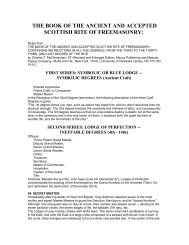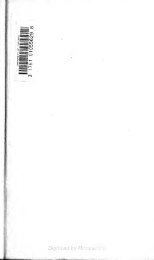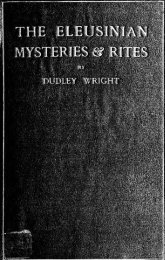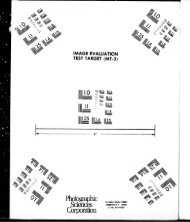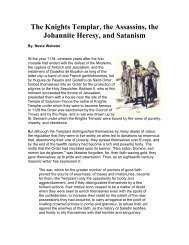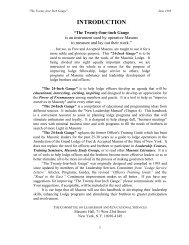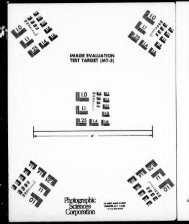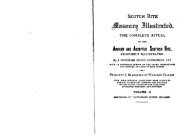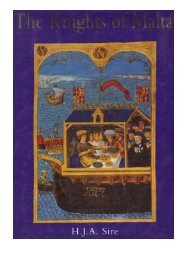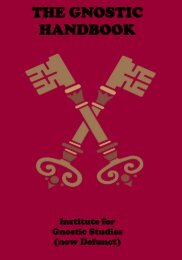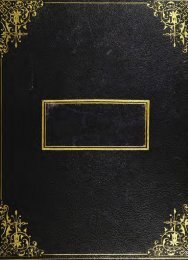The History of Initiation - The Masonic Trowel
The History of Initiation - The Masonic Trowel
The History of Initiation - The Masonic Trowel
Create successful ePaper yourself
Turn your PDF publications into a flip-book with our unique Google optimized e-Paper software.
128 HISTORY OF INITIATION.<br />
<strong>of</strong> a religious edifice f and were doubtless erected at<br />
the instance and under the direction <strong>of</strong> this priesthood<br />
to add dignity and authority to the rites <strong>of</strong> the national<br />
and hence the most herculean labours were per-<br />
religion ;<br />
formed in their construction. 48 Attached to the temple<br />
was generally placed a stone more elevated and <strong>of</strong> superior<br />
dimensions to the rest, which was worshipped as the<br />
representative <strong>of</strong> the deity. 49<br />
<strong>The</strong> general name <strong>of</strong> the sanctuary where the peculiar<br />
mysteries <strong>of</strong> Ceridwen were formally celebrated was Cacr<br />
Sidij the circle <strong>of</strong> revolution ; so called from the well<br />
known form <strong>of</strong> the Druidical temples. 50<br />
It appears ex-<br />
tremely probable that this sanctuary 51 consisted <strong>of</strong> a range<br />
47 This method <strong>of</strong> erecting temples consecrated to the celebration<br />
<strong>of</strong> divine rites, was consonant with primitive usage; for the most early<br />
patriarchal temples consisted <strong>of</strong> twelve stones placed in the open air,<br />
( Vid. Ex. xxiv., 4 ; Josh. iv., 9.) but the Druids added to the magnificence<br />
<strong>of</strong> their religious edifices, by an increased number <strong>of</strong> stones,<br />
arranged with an allusion to astronomical calculations. <strong>The</strong>y consisted<br />
chiefly <strong>of</strong> three, seven, twelve, nineteen, thirty, sixty, and one hundred<br />
and twenty stones, exclusive <strong>of</strong> the detached phalli which occupied<br />
places out <strong>of</strong> the circumference. Three referred to the divine triad<br />
Hu Ceridwin Creirwy; seven to the seven heavens which they<br />
taught were placed in the upper regions <strong>of</strong> the air ; twelve to the twelve<br />
signs <strong>of</strong> the Zodiac; nineteen to the Metonic cycle ; thirty to the famous<br />
age or generation <strong>of</strong> the Druids ; sixty to the sexagenary cycle <strong>of</strong> India,<br />
with which they were undoubtedly acquainted ; and one hundred and<br />
twenty to the double sexagenary.<br />
48 It is asserted by Stukeley, that at the present time it would cost<br />
20,000 to throw up such a mound as Silbury hill.<br />
49 <strong>The</strong> monument called Long Meg, is a fine specimen <strong>of</strong> this kind<br />
<strong>of</strong> idol.<br />
50 This phrase, according to Mr. Davies, implies "in the first place,<br />
the Ark in which the patriarch and his family were inclosed ; secondly,<br />
the circle <strong>of</strong> the Zodiac, in which their luminous emblems, the sun,<br />
moon, and planets revolved ; thirdly, the sanctuary <strong>of</strong> the British<br />
Ceres, which represented both the Ark and the zodiac." (Mytho.<br />
Druid., p. 516.)<br />
51 In the poem called Kadair Teyrn On, (Welch Arch., vol. i., p.<br />
65,) we are told that there are four grand sanctuaries in the British<br />
dominions. It would have been highly satisfactory if the bard had<br />
enumerated them. <strong>The</strong> two principal ones were doubtless that <strong>of</strong><br />
Stonehenge or Abury for the southern division <strong>of</strong> Britain ; and probably<br />
the Temple at Shap, in Cumberland, which, as Stukeley affirms,<br />
(Itin., vol. ii., p. 15,) was constructed on the plan <strong>of</strong> a serpent transmitted<br />
through a circle, and full two miles in length, for the northern<br />
division. In one <strong>of</strong> the Triads, however, (Meyrick. Cardig. Introd.,)<br />
the Bard says, "there are three principal Choirs in Britain," ajid<br />
names them as follows : <strong>The</strong> Knight Iltuds Bangor in Caer Worgorn



